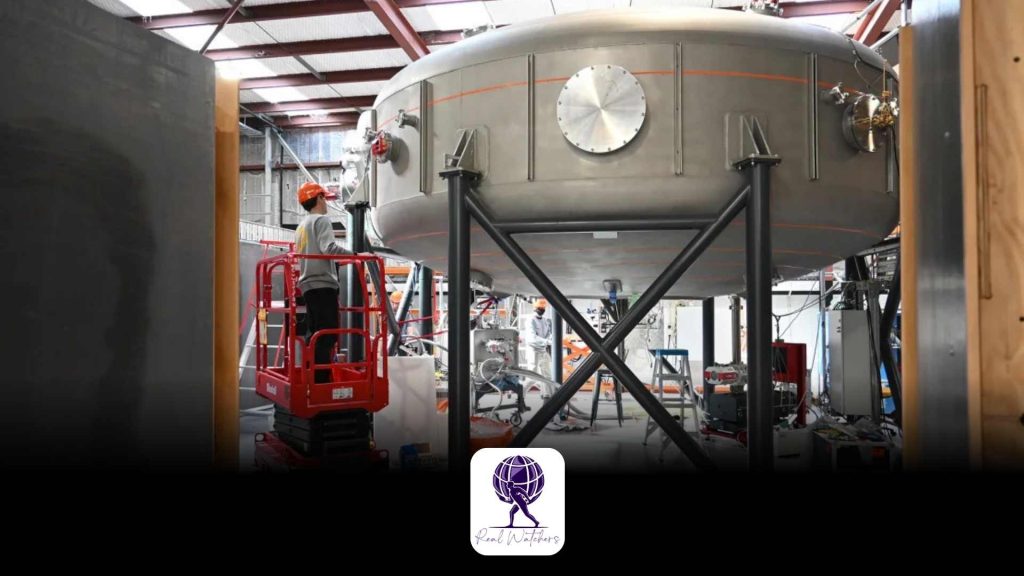In a commercial warehouse with a view of the ocean in Wellington, New Zealand’s capital, a startup is embarking on an ambitious project to replicate the energy of a star on Earth. An innovative “inside out” reactor featuring a powerful levitating magnet is at the heart of this endeavour.
The objective is to harness nuclear fusion, a virtually inexhaustible source of clean energy derived from a fundamentally different process than traditional atomic energy. Rather than splitting atoms, nuclear fusion focuses on fusing them, leading to a significant release of energy. This process utilises hydrogen, the most abundant element in the universe, as its primary fuel source.
Earlier this month, OpenStar Technologies revealed a significant breakthrough in its quest for fusion energy, successfully generating superheated plasma at temperatures reaching approximately 300,000 degrees Celsius, equivalent to 540,000 degrees Fahrenheit. This achievement marks a crucial milestone in pursuing sustainable energy solutions.
The company has described it as a significant advancement. First plasma is an important milestone, stated Ratu Mataira, the founder and CEO of OpenStar, emphasising that it represents ‘the moment that you know that everything works effectively’.
The company has invested approximately $10 million and two years to reach this milestone, he informed CNN, highlighting the efficiency and cost-effectiveness of their approach in contrast to the lengthy, government-driven initiatives that have typically characterised the fusion energy sector.
OpenStar stands out among several startups striving to advance the nuclear fusion frontier. Despite its unproven viability, the company is exploring avenues to commercialise this cutting-edge power source.
With substantial financial backing, fusion companies have garnered over $7.1 billion in investments, as the Fusion Industry Association reported. However, specialists caution that a lengthy and intricate journey lies ahead for them.
Fusion, the process responsible for the sun’s luminosity and other stars, is frequently referred to as the ultimate solution for clean energy. This method offers near-limitless potential, generates no harmful emissions contributing to global warming, and avoids the enduring radioactive waste issues associated with fission, the nuclear technology currently in use worldwide.
The initiative represents an ambitious effort to address the growing challenges of the climate crisis. Introducing a baseload power system that utilises the existing grid infrastructure presents a compelling solution for those seeking climate-friendly options. It aligns with public demand for minimal disruption to current affairs.
However, replicating it on Earth has proven to be exceptionally challenging.
A leading technology in the field is the tokamak. This doughnut-shaped machine uses two types of hydrogen gas: deuterium, sourced from seawater, and tritium, derived from lithium.
The tokamak achieves an astonishing temperature of 150 million degrees, a staggering tenfold increase compared to the sun’s core. Amid this intense heat, hydrogen isotopes collide within a plasma, leading to their fusion and generating vast amounts of energy.
In the tokamak, powerful magnetic coils play a crucial role in confining the plasma, a challenge scientists liken to the difficulty of holding Jell-O together with rubber bands.
OpenStar’s technology revolutionises the conventional approach by effectively inverting the tokamak design. In a notable shift from traditional techniques, the system features a magnet positioned within the plasma rather than the conventional method of containing plasma within magnets.
The reactor is equipped with a singular, highly potent magnet that hovers approximately 16 feet in diameter in a vacuum chamber, resembling a steel doughnut supported by legs. The design draws inspiration from the plasma found in planetary magnetic fields, notably that of Earth.
In the 1980s, physicist Akira Hasegawa introduced a groundbreaking concept, drawing from his research on plasma surrounding Jupiter. In 2004, a pioneering machine was constructed at MIT in partnership with Columbia University, marking a significant advancement in applying these principles. However, it ceased operations in 2011.
Mataira stated, “The technology they possessed was incapable of scaling.” OpenStar claims to have solved the issue by replacing certain technologies with newer magnets.
Mataira highlighted that this reactor is more straightforward and quicker to engineer than a tokamak. This enables rapid iteration and swift enhancements in performance. It is notably more concise than a tokamak, which he likens to the challenge of ‘building a ship in a bottle’. This simplicity translates to a quicker repair in case of any issues.
OpenStar, having successfully secured $12 million in funding, is now initiating a significantly larger funding round. The company aims to develop two additional prototypes over the next two to four years to determine the best strategies for scaling and ensuring viability.
OpenStar stands out among a growing number of fusion companies that have emerged in the last five years, each exploring various technologies, according to Gerald Navratil, a professor of fusion energy and plasma physics at Columbia University.
“The field has reached a level of maturity where private venture capitalists are now prepared to invest in efforts to accelerate the pursuit of fusion,” he stated in an interview with CNN.
Commonwealth Fusion Systems, a significant commercial fusion player, has secured over $2 billion in funding. The company is known for its innovative use of high-temperature superconducting magnets in a tokamak design.
Other companies, such as OpenStar, are delving into more unconventional technology. Zap Energy, a company located in Seattle, is working on developing a compact and scalable reactor that operates without magnets. Instead, the innovative design involves firing power pulses into a plasma stream.
The pressing inquiry remains: when will fusion power become a viable energy source? OpenStar has announced a timeline of six years. Commonwealth Fusion has announced its goal to provide fusion power to the electrical grid by the early 2030s. Zap Energy anticipates a comparable timeline.
Some players exhibit a more cautious approach. The UK Atomic Energy Authority, a government organisation focused on fusion development, has stated that commercial fusion will likely materialise in the latter half of this century, citing substantial scientific and engineering hurdles that still need to be overcome.
Navratil noted that startups often tend to be aggressive in their promises. He emphasised that while generating energy from fusion is one thing, establishing a practical system that safely delivers power to the grid, is licensed, and is fully operational represents a significant challenge.
Mataira expresses optimism regarding the potential of agile startups to accelerate the global transition to clean power, a goal that has long appeared elusive.
“While not every fusion company is destined for success, OpenStar could be among those that falter,” he stated, “yet we, as a society, will accelerate our learning.”








